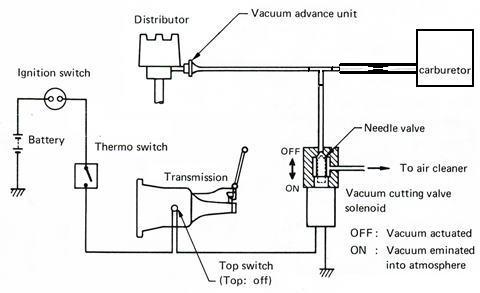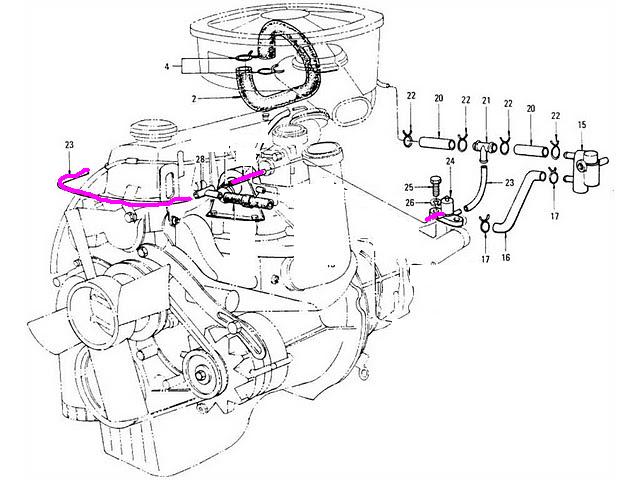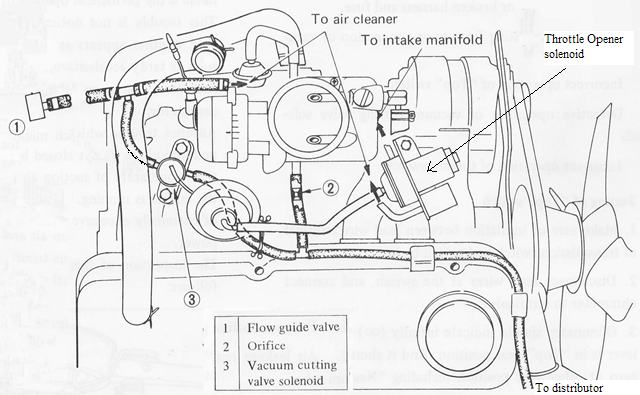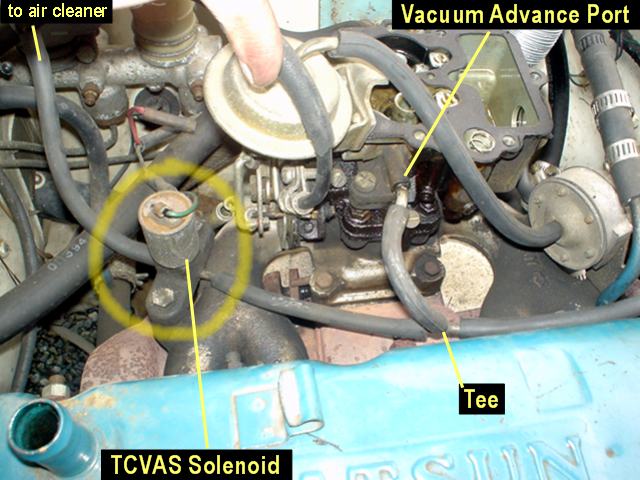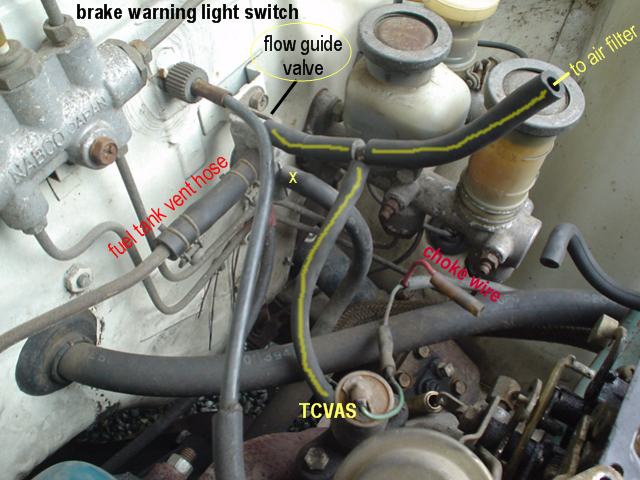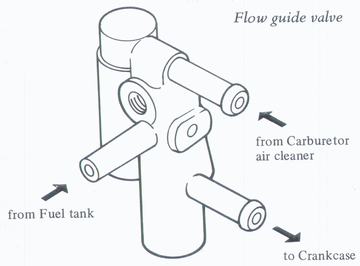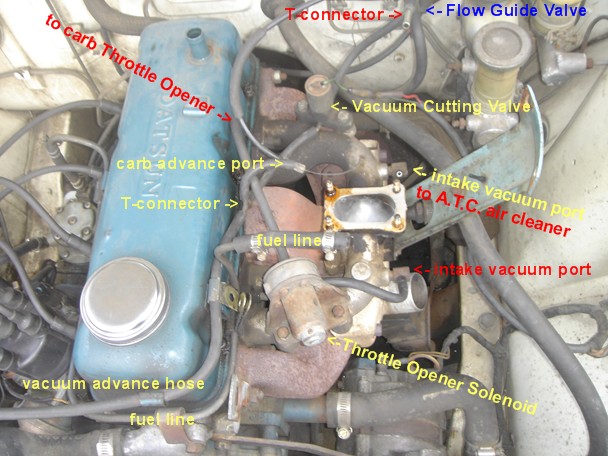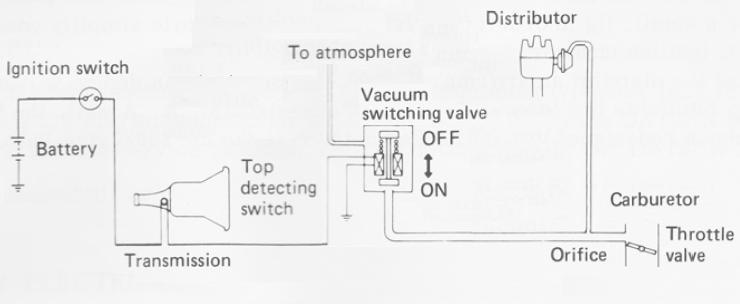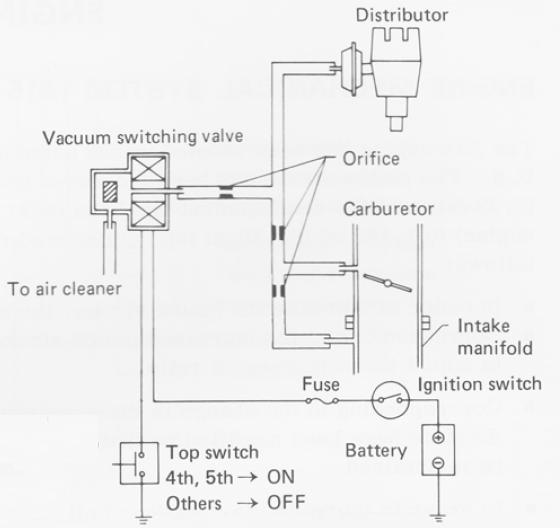| Revision as of 00:45, 8 May 2014 ddgonzal (Talk | contribs) <- Previous diff |
Current revision ddgonzal (Talk | contribs) (->Overview) |
||
| Line 1: | Line 1: | ||
| - | Starting with 1972 USA models and 1976 Australian models, '''Transmission Controlled Vacuum Advance System''' (TCVAS) disables spark advance except in Top Gear. Since this "retarded" spark timing reduces performance, to prevent cold-engine driving problems this system is bypassed in cold temperatures. This means vacuum advance works normally at cold cabin temperatures. | + | Starting with 1972 USA models and 1976 Australian models, '''Transmission Controlled Vacuum Advance System''' (TCVAS) disables spark advance except in Top Gear. Since this "retarded" spark timing reduces performance, to prevent cold-engine driving problems this system is bypassed in cold temperatures. This means vacuum advance works normally at cold temperatures. On the highway (in top gear) full power is always available. |
| + | |||
| = Applications = | = Applications = | ||
| USA | USA | ||
| Line 10: | Line 11: | ||
| = Overview = | = Overview = | ||
| [[Vacuum advance]] in all models uses a hose from the Distributor to the 'port' on the carburetor. | [[Vacuum advance]] in all models uses a hose from the Distributor to the 'port' on the carburetor. | ||
| - | <br>[http://datsun1200.com/modules/myalbum/photo.php?lid=25458 http://datsun1200.com/uploads/thumbs/25458.jpg] | + | <br>{{Album|25458}} |
| <br>In the TCVAS system, however, there is a valve inserted into the hose to affect the vacuum. | <br>In the TCVAS system, however, there is a valve inserted into the hose to affect the vacuum. | ||
| - | [http://datsun1200.com/modules/myalbum/photo.php?lid=14984 http://datsun1200.com/uploads/thumbs/14984.jpg] | + | {{Album|14984}} |
| - | The vacuum valve is electrically controlled. With 12V supplied, vacuum is bled off. From a performance standpoint, this is fairly foolproof because if a wire is disconnected it works with normal advance. Only when correctly wired does it affect vacuum advance. | + | The vacuum valve is electrically controlled. With 12V supplied, vacuum is bled off. From a performance standpoint, this is fairly foolproof because if a wire is disconnected it works with normal advance. Only when correctly wired does it affect vacuum advance. |
| - | '''Note''' that since [[Ignition Timing]] is set with distributor hose disconnected and plugged, a malfunction in the TCVAS will: | + | The good news is that a malfunction in the TCVAS will: |
| * not affect the Ignition Timing procedure | * not affect the Ignition Timing procedure | ||
| * not affect idle-speed setting | * not affect idle-speed setting | ||
| - | <blockquote><table border=1><tr><td> | + | {{OwnersManual2x|29390|p1=30|29391|p2=31|<strong>Transmission-controlled Vacuum Advance (Manual Transmission Cars)</strong> |
| - | <center>USA 1972 [[Owners manual]] (pages 30, 31): | + | |
| - | [http://s297.photobucket.com/albums/mm219/ddgonzal/Datsun%201200/owners_manual/1972/30.jpg http://s297.photobucket.com/albums/mm219/ddgonzal/Datsun%201200/owners_manual/1972/th_30.jpg] [http://s297.photobucket.com/albums/mm219/ddgonzal/Datsun%201200/owners_manual/1972/31.jpg http://s297.photobucket.com/albums/mm219/ddgonzal/Datsun%201200/owners_manual/1972/th_31.jpg]</center><blockquote><strong>Transmission-controlled Vacuum Advance (Manual Transmission Cars)</strong> | + | |
| <br><br> | <br><br> | ||
| The system provides the vacuum advance only when the gear is shifted to the Top (4th) position, and retarded spark timing (with no vacuum advance) at other positions for complete combustions. | The system provides the vacuum advance only when the gear is shifted to the Top (4th) position, and retarded spark timing (with no vacuum advance) at other positions for complete combustions. | ||
| Line 34: | Line 33: | ||
| <br>Examine the transmission-controlled vacuum advance for proper function. Its maintenance is to be performed every 12 months or 12,000 miles (20,000 km), whichever occurs first.</i> | <br>Examine the transmission-controlled vacuum advance for proper function. Its maintenance is to be performed every 12 months or 12,000 miles (20,000 km), whichever occurs first.</i> | ||
| <br><br> | <br><br> | ||
| - | Note: The engine service points indicated in the "Periodic Maintenance and Lubrication Schedule" of this manual should be checked and adjusted at the respective intervals as designated.</blockquote></td></tr></table></blockquote> | + | Note: The engine service points indicated in the "Periodic Maintenance and Lubrication Schedule" of this manual should be checked and adjusted at the respective intervals as designated.}} |
| = Components = | = Components = | ||
| Line 41: | Line 40: | ||
| * Electrical "[[Top Switch]]" screwed into the side of the transmission (left side, near the bell housing). It is closed in top gear (allowing regular advance), open in all other gears and neutral (disabling advance) | * Electrical "[[Top Switch]]" screwed into the side of the transmission (left side, near the bell housing). It is closed in top gear (allowing regular advance), open in all other gears and neutral (disabling advance) | ||
| * Electrical '''Vacuum Cutting Valve Solenoid''' 14955-H3900. When energized, it bleeds off the vacuum advance | * Electrical '''Vacuum Cutting Valve Solenoid''' 14955-H3900. When energized, it bleeds off the vacuum advance | ||
| - | |||
| <blockquote>CAUTION: Using a normal hose from the carb to the T-connector results in a small vacuum leak. Only use the special orifice-restricted hose.</blockquote> | <blockquote>CAUTION: Using a normal hose from the carb to the T-connector results in a small vacuum leak. Only use the special orifice-restricted hose.</blockquote> | ||
| - | The thermo switch is located inside the passenger compartment: | + | The thermo switch is located inside the passenger compartment (Location: Under dash, right side of car): |
| - | <br>[http://datsun1200.com/modules/myalbum/photo.php?lid=14980 http://datsun1200.com/uploads/thumbs/14980.jpg] [http://datsun1200.com/modules/myalbum/photo.php?lid=14973 http://datsun1200.com/uploads/thumbs/14973.jpg] | + | <br>{{Album|14980}} {{Album|14973}} |
| - | <br>Location: Under dash, right side of car | + | |
| The thermostatic switch: | The thermostatic switch: | ||
| Line 57: | Line 54: | ||
| <blockquote>Tip: To prevent advance cut-out, leave heater off and roll down the windows.</blockquote> | <blockquote>Tip: To prevent advance cut-out, leave heater off and roll down the windows.</blockquote> | ||
| - | Solenoid Location: just aft of carbuetor, bolted to the intake manifold. | + | Solenoid Location on B110: just aft of carburetor, bolted to the intake manifold. |
| - | <br>[http://datsun1200.com/modules/myalbum/photo.php?lid=2211 http://datsun1200.com/uploads/thumbs/2211.jpg] | + | <br>{{Photo|B110_TCVAS.jpg}} |
| - | <br>It is the cylinder on the right (with green wire), seen just below the throttle opener | + | |
| + | Solenoid location on 1978 B210 USA | ||
| + | <br>{{UploadPost|174_5dd1c12983fdf.jpg|493093|was=20090816175554DSC08722.jpg-Datsun%20Misc/B210}} | ||
| + | |||
| + | == Water Temperature Thermostat == | ||
| + | Australia used water temps, instead of air temps. TCVAS was disabled when engine coolant temperature was low, using this thermostat. | ||
| + | <br>{{Album|6927}} | ||
| + | |||
| + | TCVAS relay 25230-H1604 RELAY ASSY-WATER TEMPERATURE F/WATER TEMP used on 1985 models | ||
| + | <br>{{UploadPost|17122_5dc4b9ece1c79.jpg|493027}} | ||
| + | |||
| + | Plug Wiring | ||
| + | * B - Black | ||
| + | * Y - Yellow | ||
| + | * LR - Blue wire with Red stripe | ||
| = Schematic = | = Schematic = | ||
| Both vacuum and electricity are used. | Both vacuum and electricity are used. | ||
| - | [http://datsun1200.com/modules/myalbum/photo.php?lid=14984 http://datsun1200.com/uploads/thumbs/14984.jpg] [http://datsun1200.com/modules/myalbum/photo.php?lid=25457 http://datsun1200.com/uploads/thumbs/25457.jpg] | + | {{Album|14984}} {{Album|25457}} |
| In cold weather, vacuum advance is normal | In cold weather, vacuum advance is normal | ||
| Until car warms up... | Until car warms up... | ||
| - | [http://datsun1200.com/modules/myalbum/photo.php?lid=14985 http://datsun1200.com/uploads/thumbs/14985.jpg] | + | {{Album|14985}} |
| <br>56-series 4-speed (LHD) | <br>56-series 4-speed (LHD) | ||
| <br>[[Top Switch]] (emission controlled models) | <br>[[Top Switch]] (emission controlled models) | ||
| - | + | </b | |
| When current flows to the '''Vacuum Cutting Solenoid''', it cuts the vacuum advance. | When current flows to the '''Vacuum Cutting Solenoid''', it cuts the vacuum advance. | ||
| - | If the Solenoid is disconnected, | + | <blockquote>If the Solenoid wire is disconnected, e.g. by vibration or by corrosion, vacuum advance works normally.</blockquote> |
| - | vacuum advance works normally. | + | |
| - | + | ||
| The '''Top Switch''' is normally closed, thus causing the solenoid valve to open, bleeding off the vacuum advance signal. Only in top gear (4th) does it become electrically open, causing the valve to deactivate, no longer bleeding the vacuum advance hose. | The '''Top Switch''' is normally closed, thus causing the solenoid valve to open, bleeding off the vacuum advance signal. Only in top gear (4th) does it become electrically open, causing the valve to deactivate, no longer bleeding the vacuum advance hose. | ||
| Line 88: | Line 97: | ||
| = Vacuum Hoses = | = Vacuum Hoses = | ||
| Vacuum advance in all models uses a hose from the 'port' on the carburetor to the Distributor. | Vacuum advance in all models uses a hose from the 'port' on the carburetor to the Distributor. | ||
| - | <br>[http://datsun1200.com/modules/myalbum/photo.php?lid=2216 http://datsun1200.com/uploads/thumbs/2216.jpg] [http://datsun1200.com/modules/myalbum/photo.php?lid=2214 http://datsun1200.com/uploads/thumbs/2214.jpg] | + | <br>{{Album|26008}} |
| + | |||
| + | {{Photo|B110_advance_hoses.jpg}} | ||
| TCVAS adds to this, by adding a 'T' in the line. The 'T' carries vacuum to the '''Vacuum Cutting Valve Solenoid''', which when electrically powered dumps the vacuum to the atmosphere. This effectively 'cuts' vacuum advance, while the small orifice prevents a vacuum leak. The orifice is in the special hose going from carburetor spark-port to the 'T'. | TCVAS adds to this, by adding a 'T' in the line. The 'T' carries vacuum to the '''Vacuum Cutting Valve Solenoid''', which when electrically powered dumps the vacuum to the atmosphere. This effectively 'cuts' vacuum advance, while the small orifice prevents a vacuum leak. The orifice is in the special hose going from carburetor spark-port to the 'T'. | ||
| - | [http://datsun1200.com/modules/myalbum/photo.php?lid=11627 http://datsun1200.com/uploads/thumbs/11627.jpg] | + | {{Album|11627}} |
| - | [http://datsun1200.com/modules/myalbum/photo.php?lid=14988 http://datsun1200.com/uploads/thumbs/14988.jpg] | + | {{Album|14988}} |
| The source of air to the Valve is both: | The source of air to the Valve is both: | ||
| * underside of air cleaner | * underside of air cleaner | ||
| * Flow guide valve | * Flow guide valve | ||
| - | *: [http://datsun1200.com/modules/myalbum/photo.php?lid=7799 http://datsun1200.com/uploads/thumbs/7799.jpg] | + | {{Album|14989}} {{Album|7799}} {{Album|15961}} |
| + | |||
| + | = Disabling = | ||
| + | For racing or farm use (where emission controls are not required), simply connect the distributor [[Vacuum Advance]] directly to the carburetor. This will allow full spark advance. | ||
| + | |||
| + | {{Album|25458}} | ||
| + | |||
| + | = Testing = | ||
| + | You can temporarily bypass TCVAS to see if it clears up a poor-running engine. See section above. You will likely find the car runs the same with TCVAS disabled. If so, re-enable it to help with clean air. | ||
| + | |||
| + | If the engine runs remarkably better with TCVAS bypassed, the cause may be: | ||
| + | * incorrect hose connections | ||
| + | * broken distributor vacuum advance module | ||
| + | * temp switch stuck closed | ||
| + | |||
| + | = Spark Delay = | ||
| + | Manual transmission models used TCVAS. For the B210 (e.g. 1978), auto-equipped cars got a spark delay valve inserted into the vacuum advance hose. | ||
| + | |||
| + | = TCS = | ||
| + | 1979 Datsun 620 pickup for USA uses TCS (Transmission Controlled Spark), which is identical to B110 TCVAS except there is no bypass for cold temperature. | ||
| + | |||
| + | {{Album|25461}} | ||
| + | |||
| + | Only used with manual transmission. Also used on 1978 Cab & Chassis models. | ||
| + | |||
| + | Also see: [[Top Switch]] | ||
| + | |||
| + | = TVCAS with Dual Control = | ||
| + | TVCAS was also used with [[Vacuum_advance#Dual_Control|Dual Control Vacuum Advance]], as on the 1979 B310 with fuel economy engine. | ||
| + | |||
| + | The TVCAS portion of this system works exactly as in B110: A valve that bleeds the vacuum advance hose when in Top Gear. | ||
| - | [http://datsun1200.com/modules/myalbum/photo.php?lid=14989 http://datsun1200.com/uploads/thumbs/14989.jpg] | + | {{Album|25460}} |
| - | [http://datsun1200.com/modules/myalbum/photo.php?lid=15961 http://datsun1200.com/uploads/thumbs/15961.jpg] | + | Differences from B110 |
| + | * Top is 4th or 5th gear | ||
| + | * no temperature switch | ||
| - | [[Category:Emission Control And Tune-Up]] | + | [[Category:Emission Control And Tune-Up]]{{End}} |
Current revision
Starting with 1972 USA models and 1976 Australian models, Transmission Controlled Vacuum Advance System (TCVAS) disables spark advance except in Top Gear. Since this "retarded" spark timing reduces performance, to prevent cold-engine driving problems this system is bypassed in cold temperatures. This means vacuum advance works normally at cold temperatures. On the highway (in top gear) full power is always available.
Contents |
Applications
USA 1972-1973 B110 1974-1978 B210
AUSTRALIA 1976-1978 B120
Overview
Vacuum advance in all models uses a hose from the Distributor to the 'port' on the carburetor.
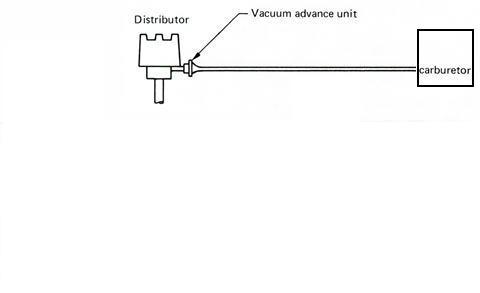
In the TCVAS system, however, there is a valve inserted into the hose to affect the vacuum.
The vacuum valve is electrically controlled. With 12V supplied, vacuum is bled off. From a performance standpoint, this is fairly foolproof because if a wire is disconnected it works with normal advance. Only when correctly wired does it affect vacuum advance.
The good news is that a malfunction in the TCVAS will:
- not affect the Ignition Timing procedure
- not affect idle-speed setting
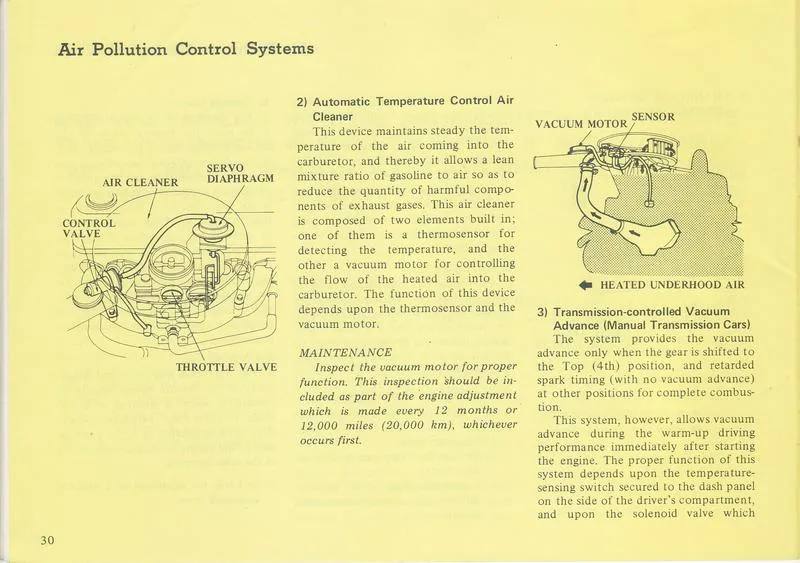 Transmission-controlled Vacuum Advance (Manual Transmission Cars)
Transmission-controlled Vacuum Advance (Manual Transmission Cars)
The system provides the vacuum advance only when the gear is shifted to the Top (4th) position, and retarded spark timing (with no vacuum advance) at other positions for complete combustions.
This system, however, allows vacuum advance during the warm-up driving performance immediately after starting the engine. The proper function of this system depends upon the temperature-sensing switch secured to the dash panel on the side of the driver's compartment, and upon the solenoid valve which advances the ignition timing by conducting vacuum. The controls used in this system are shown in the below illustration.
Note: The Top gear (4th) switch actuates only when the transmission is shifted to 4th gear.
MAINTENANCE
Examine the transmission-controlled vacuum advance for proper function. Its maintenance is to be performed every 12 months or 12,000 miles (20,000 km), whichever occurs first.
Note: The engine service points indicated in the "Periodic Maintenance and Lubrication Schedule" of this manual should be checked and adjusted at the respective intervals as designated.
Components
- Vacuum Hose 14956-H3901 with special orifice-restriction between carb and tee-connector connected to the vacuum advance hose. This has a precision orifice (jet) in it to control flow of air
- Electrical Thermo switch 22110-N0901 in cabin, under dash mounted high on the right-side kick panel. This is a little round button-shaped unit. It is a simple on/off thermostat which turns "On" as temperature raises past 41-55 degrees. It turns "Off" when temperature falls below 34 degrees
- Electrical "Top Switch" screwed into the side of the transmission (left side, near the bell housing). It is closed in top gear (allowing regular advance), open in all other gears and neutral (disabling advance)
- Electrical Vacuum Cutting Valve Solenoid 14955-H3900. When energized, it bleeds off the vacuum advance
CAUTION: Using a normal hose from the carb to the T-connector results in a small vacuum leak. Only use the special orifice-restricted hose.
The thermo switch is located inside the passenger compartment (Location: Under dash, right side of car):

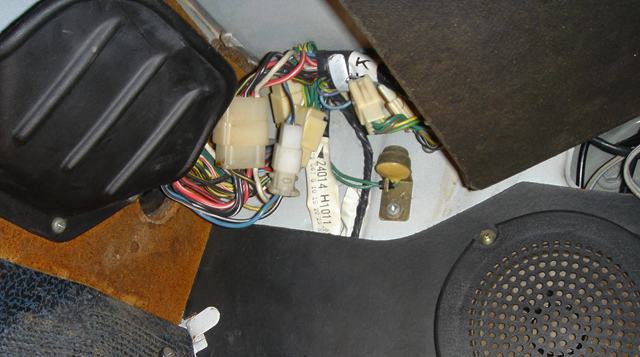
The thermostatic switch: * Conducts between 41F and 55 F as temperature rises Ohmmeter should indicates 0 above 55 degrees * Disconnects below 34F as temperature falls Ohmmeter should indicate infinity (~) below 34 degrees
Tip: To prevent advance cut-out, leave heater off and roll down the windows.
Solenoid Location on B110: just aft of carburetor, bolted to the intake manifold.

Solenoid location on 1978 B210 USA
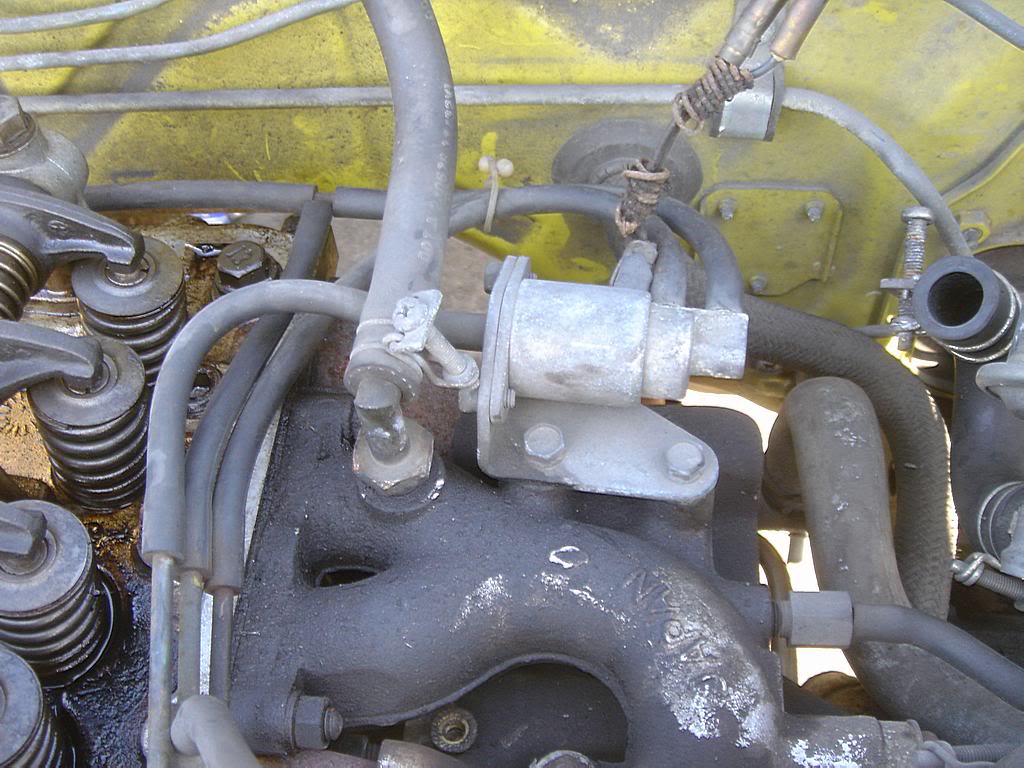
Water Temperature Thermostat
Australia used water temps, instead of air temps. TCVAS was disabled when engine coolant temperature was low, using this thermostat.
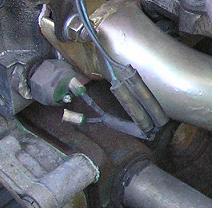
TCVAS relay 25230-H1604 RELAY ASSY-WATER TEMPERATURE F/WATER TEMP used on 1985 models
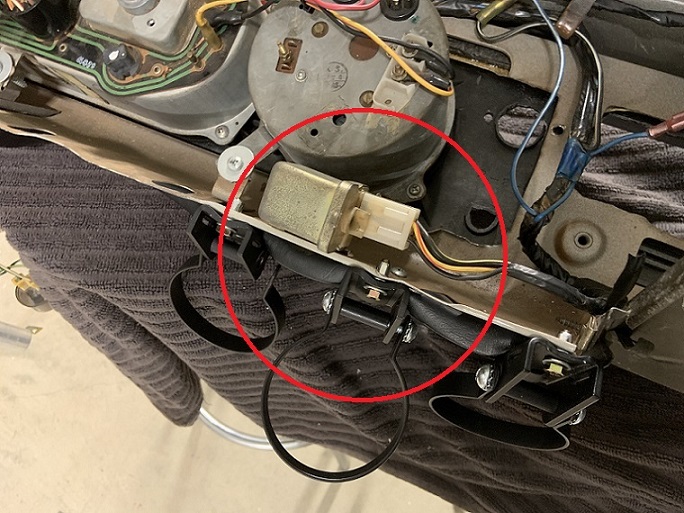
Plug Wiring * B - Black * Y - Yellow * LR - Blue wire with Red stripe
Schematic
Both vacuum and electricity are used.
In cold weather, vacuum advance is normal Until car warms up...

56-series 4-speed (LHD)
Top Switch (emission controlled models)
</b
When current flows to the Vacuum Cutting Solenoid, it cuts the vacuum advance.
If the Solenoid wire is disconnected, e.g. by vibration or by corrosion, vacuum advance works normally.
The Top Switch is normally closed, thus causing the solenoid valve to open, bleeding off the vacuum advance signal. Only in top gear (4th) does it become electrically open, causing the valve to deactivate, no longer bleeding the vacuum advance hose.
If you neglect to connect the top switch, vacuum advance works normally.
So this is nearly a foolproof system. If any electrical component goes bad or is not connected, normal operation occurs. Only when every electric circuit is working does it cut vacuum advance.
Vacuum Hoses
Vacuum advance in all models uses a hose from the 'port' on the carburetor to the Distributor.
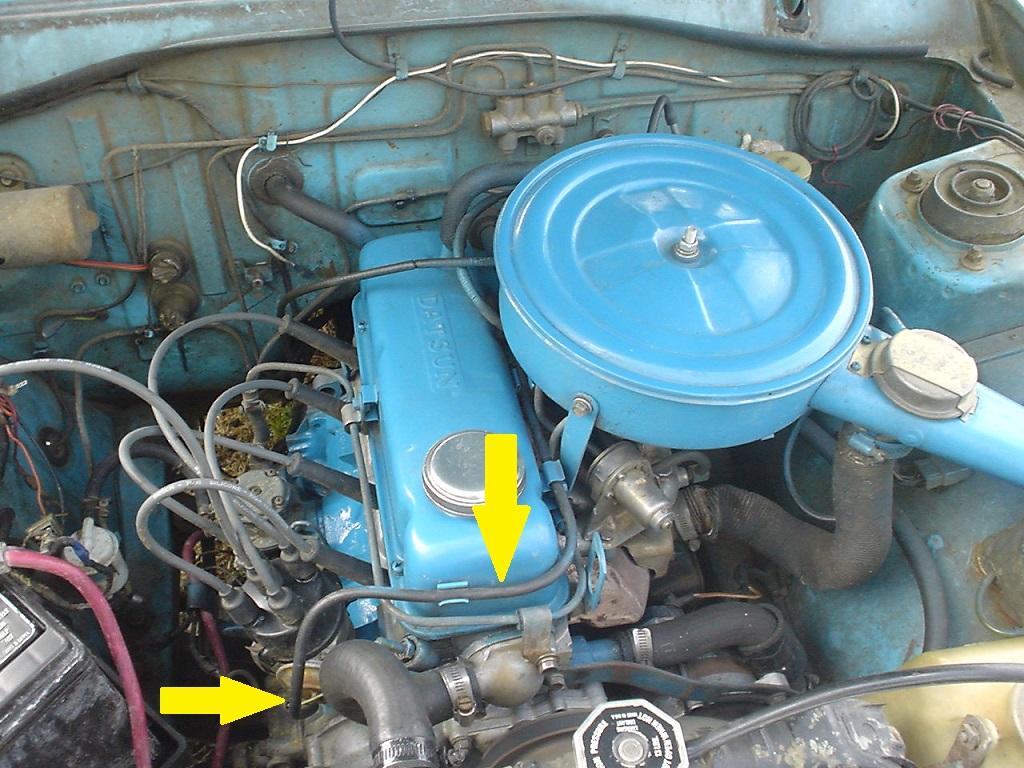
TCVAS adds to this, by adding a 'T' in the line. The 'T' carries vacuum to the Vacuum Cutting Valve Solenoid, which when electrically powered dumps the vacuum to the atmosphere. This effectively 'cuts' vacuum advance, while the small orifice prevents a vacuum leak. The orifice is in the special hose going from carburetor spark-port to the 'T'.
The source of air to the Valve is both:
- underside of air cleaner
- Flow guide valve
Disabling
For racing or farm use (where emission controls are not required), simply connect the distributor Vacuum Advance directly to the carburetor. This will allow full spark advance.
Testing
You can temporarily bypass TCVAS to see if it clears up a poor-running engine. See section above. You will likely find the car runs the same with TCVAS disabled. If so, re-enable it to help with clean air.
If the engine runs remarkably better with TCVAS bypassed, the cause may be:
- incorrect hose connections
- broken distributor vacuum advance module
- temp switch stuck closed
Spark Delay
Manual transmission models used TCVAS. For the B210 (e.g. 1978), auto-equipped cars got a spark delay valve inserted into the vacuum advance hose.
TCS
1979 Datsun 620 pickup for USA uses TCS (Transmission Controlled Spark), which is identical to B110 TCVAS except there is no bypass for cold temperature.
Only used with manual transmission. Also used on 1978 Cab & Chassis models.
Also see: Top Switch
TVCAS with Dual Control
TVCAS was also used with Dual Control Vacuum Advance, as on the 1979 B310 with fuel economy engine.
The TVCAS portion of this system works exactly as in B110: A valve that bleeds the vacuum advance hose when in Top Gear.
Differences from B110 * Top is 4th or 5th gear * no temperature switch

![[Datsun 1200 encyclopedia]](/wiki/upload/wiki.png)
